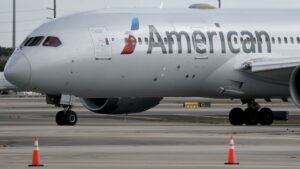American Airlines Faces Uncertainty as It Withdraws 2025 Financial Guidance
As we navigate through 2023, American Airlines finds itself in a challenging position, having recently withdrawn its financial guidance for the year 2025. This move aligns with a broader trend among airlines adjusting their outlook in response to shifting economic conditions and unexpected drops in leisure travel bookings. At Extreme Investor Network, we believe in providing unparalleled insights into such critical developments, equipping our readers with the knowledge to make informed decisions in the ever-evolving business landscape.
The Current Landscape
During a recent appearance on CNBC’s "Squawk Box," CEO Robert Isom shed light on the airline’s predicament. Reflecting on the preceding months, he stated, "We came off a strong fourth quarter, saw decent business in January, and really domestic leisure travel fell off considerably into February." This observation raises questions about the future trajectory of air travel and the economic factors influencing consumer behavior.
While American Airlines reported a modest 0.7% increase in unit revenue for the first quarter, this growth was primarily fueled by international bookings and premium cabin sales. Isom’s comments echoed sentiments shared by executives from competitors such as Delta and United Airlines. These carriers have similarly reported that price-sensitive leisure travelers are hesitant to make travel commitments, which significantly impacts overall bookings.
An Unpredictable Outlook
Looking ahead, American Airlines has forecasted potential revenue drops for the second quarter, predicting declines of up to 2% year-over-year. This projection falls short of analysts’ expectations of a 2.2% growth. Despite this downturn, the airline anticipates an increase in capacity of 2% to 4%.
As investors, understanding the financial implications of these forecasts is vital. American Airlines expects adjusted earnings per share to be between $0.50 and $1.00, far below the anticipated $0.99. This indicates a gap between what the market expects and what the airline is willing to admit, further highlighting the overarching uncertainty.
Financial Performance Snapshot
Here’s a concise comparison of American Airlines’ first-quarter performance against Wall Street’s estimates, compiled by LSEG:
- Loss Per Share: Adjusted loss of $0.59 vs. an expected loss of $0.65
- Revenue: $12.55 billion vs. expected $12.6 billion
In a broader context, the airline reported a staggering $473 million loss for the first quarter, significantly larger than the $312 million loss from the same period last year. This decline was compounded by an overall capacity drop of 0.8%, emphasizing the strain on operations.
Factors Contributing to the Shift
American Airlines’ struggle to rebound from previous strategic missteps, particularly in its corporate travel sector, has been another point of contention. Although efforts are underway to revitalize this segment, external economic uncertainties and unfortunate incidents—like the tragic accident involving American Eagle Flight 5342—are clouding recovery prospects. Such events inevitably affect consumer confidence and travel patterns, further complicating the airline’s path forward.
Conclusion: What’s Next for Investors?
For those invested in the airline sector or considering entering, the challenges faced by American Airlines present both risks and opportunities. With a keen eye on economic indicators and consumer behavior, investors can gauge how airlines like American will adapt to the fluctuating travel landscape.
At Extreme Investor Network, we’re committed to delivering real-time analysis and actionable insights that help our readers make better investment choices. Stay tuned for more updates as we continue to monitor the evolving landscape of the airline industry and its implications for investors.

